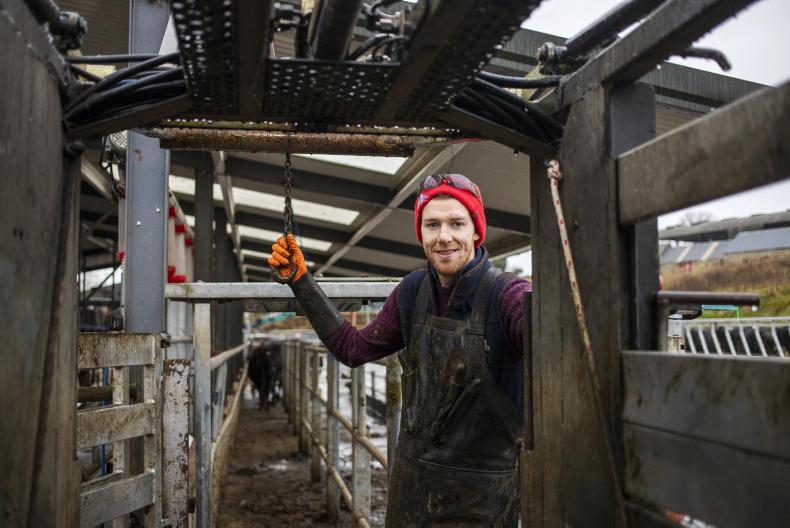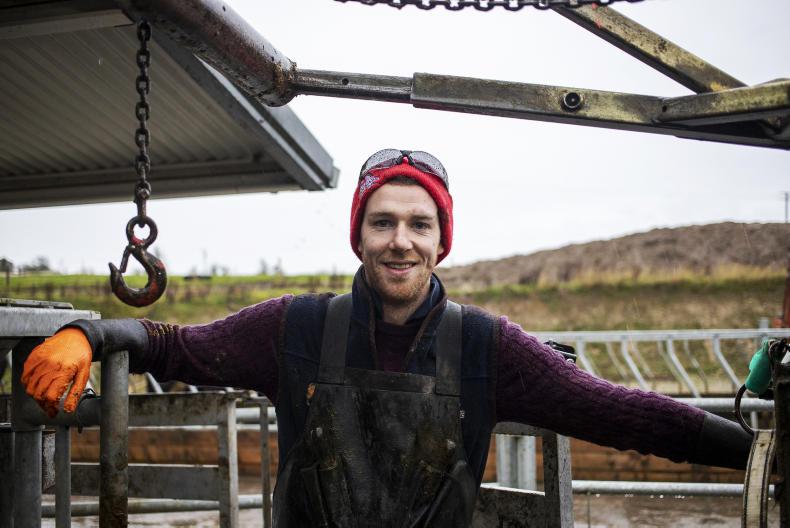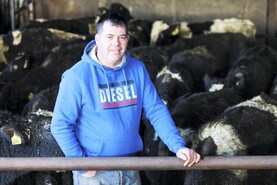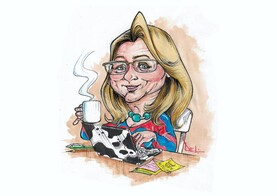Robert Dawson’s office is the driver seat of his jeep. His mobile crush is his business. His phone is his secretary.
This hoof trimmer from Co Carlow went into business in February 2019 after he bought a secondhand Wopa 51 stand-up crate from Northern Ireland.
On a typical day, Robert is on the road by 8.15am, heading to his first customer.
“I’d drive to the yard and will have all my products like bandages and shoes with me, make sure the machine is greased up, clean and disinfected.
“I don’t want to transfer mortal arrow (digital dermatitis) from one farm to the next. I sharpen the knives every day as well,” he tells Irish Country Living.

Robert says you wouldn’t want to be queasy as a hoof trimmer. \ Claire Jeanne Nash
“A lot of the farms I know where I’m setting up. I like being beside a crush, it’s the safest place really. I think a lot of farmers need to update their crush system, to make it easier on themselves.”
To pare a cow Robert says can take anywhere from five to 15 minutes depending on the problem. A more common problem like Mortellaro’s disease (digital dermatitis) will only take five minutes.
There are a few farms around that have astroturf, but is very expensive to put down
“But it could take up to 10 minutes on a sole ulcer and white line disease. Farmers would be talking about why the problems are happening. A lot of it would be roadways.
“You don’t want rough roadways, you want fine stones, astroturf or concrete. There are a few farms around that have astroturf, but is very expensive to put down.”
After just one year in business, Robert’s opinion is that there are four main foot problems on farms. Mortellaro’s disease, sole ulcers, white line disease and toe necrosis are the key issues.

Robert advises to get trained in hoof trimming before going into business with it. \ Claire Jeanne Nash
“Mortellaro’s disease is a big problem, there needs to be more foot bathing and hoof trimming.
“I use a heel max paste to kill the mortal arrow and I find it excellent. I tell the farmer to leave the bandage on for three days to kill the mortal arrow out of the hoof.
Sole ulcers are a big problem which can depend on age and diet
“You can also get it in a five-gallon drum and use it as a foot bath,” Robert says.
“Sole ulcers are a big problem which can depend on age and diet. You need to get the weight on the healthier claw by using a block or shoe.
“White line disease is a non-infectious condition that occurs when the sole separates from the side wall of the hoof, allowing dirt to penetrate and infect the white line. It mostly happens with older cows.
“To treat it I would be taking away all the lose horn and putting alamycin spray on it and putting a block on to the healthier claw.”
The other problem Robert sees is toe necrosis which is an abscess on the toe, which you see in feedlot cattle and is likely to be a consequence of excessive abrasive damage to the hoof. This is treated in a similar way to white line disease.
To prevent mortal arrow, Robert advises farmers that cleanliness is key. He recommends automatic scrapers and foot bathing because it is a bacterial disease.
Training
The idea of starting a hoof-trimming business came to Robert when he was working in the UK. He visited quite a few dairy farms, working for Case in Devon as a tractor demonstrator.
“I asked what they did with lame cows and they said they got hoof trimmers in.
“So I did a bit of research, came home to the mart and asked how long farmers were waiting for a hoof trimmer. They said four to five weeks, so I saw an opening there.”
Robert came home and did a hoof-trimming courses with Dúnmasc Genetics and Macra na Feirme’s Skillnet programme.

A stand-up crate is Robert’s method of hoof trimming. \ Claire Jeanne Nash
After that, he gained some experience with other hoof trimmers – Cyril Wheelock, Tommy Cullen and John Connolly – before setting up his own business .
“The way I was taught in the course, I went with a stand-up crate. I think it’s better for the cow and less stressful,” Robert said.
“I find a lot of people coming into the winter months would be asking to do a whole herd. I’d do about 60 to 70 cows in a day.
There is a good network of us though and if you’re stuck you pass work onto the next lad
“A lot of the hoof trimmers are in their 40s or 50s and there is a lot of loyalty to lads.
“There is a good network of us though and if you’re stuck you pass work onto the next lad.”
If someone is thinking of getting into hoof trimming, Robert recommends doing the course and getting experience firstly.
“It’s not necessarily a pleasant job, you have to be good and patient with animals. And you wouldn’t want to be queasy.”

In terms of the mood on the ground among farmers, Robert says the farmers he visits are wondering if the dairy bubble will last.
“Every farmer in Ireland works very hard to put food on the table”.
Normally two or three farm visits is the maximum he will get to in a day, depending on whether it is a full herd or just a few cows.
“Sometimes I would do feet after an evening milking if I had a big herd in the morning.
“Two or three farms would be the max I’d do in a day. Normally I’d finish up around half six or seven in the evening.”
For Robert, the aim is to help as many lame cows as possible. His father is well-known auctioneer John Dawson of REA Tullow.
Robert’s plan is to go into the family business someday. But, for now, the jeep will remain his office.
Read more
A day in the life of: a farmer on the beat
A day in the life of: a kiwi milking cows in Ireland
Robert Dawson’s office is the driver seat of his jeep. His mobile crush is his business. His phone is his secretary.
This hoof trimmer from Co Carlow went into business in February 2019 after he bought a secondhand Wopa 51 stand-up crate from Northern Ireland.
On a typical day, Robert is on the road by 8.15am, heading to his first customer.
“I’d drive to the yard and will have all my products like bandages and shoes with me, make sure the machine is greased up, clean and disinfected.
“I don’t want to transfer mortal arrow (digital dermatitis) from one farm to the next. I sharpen the knives every day as well,” he tells Irish Country Living.

Robert says you wouldn’t want to be queasy as a hoof trimmer. \ Claire Jeanne Nash
“A lot of the farms I know where I’m setting up. I like being beside a crush, it’s the safest place really. I think a lot of farmers need to update their crush system, to make it easier on themselves.”
To pare a cow Robert says can take anywhere from five to 15 minutes depending on the problem. A more common problem like Mortellaro’s disease (digital dermatitis) will only take five minutes.
There are a few farms around that have astroturf, but is very expensive to put down
“But it could take up to 10 minutes on a sole ulcer and white line disease. Farmers would be talking about why the problems are happening. A lot of it would be roadways.
“You don’t want rough roadways, you want fine stones, astroturf or concrete. There are a few farms around that have astroturf, but is very expensive to put down.”
After just one year in business, Robert’s opinion is that there are four main foot problems on farms. Mortellaro’s disease, sole ulcers, white line disease and toe necrosis are the key issues.

Robert advises to get trained in hoof trimming before going into business with it. \ Claire Jeanne Nash
“Mortellaro’s disease is a big problem, there needs to be more foot bathing and hoof trimming.
“I use a heel max paste to kill the mortal arrow and I find it excellent. I tell the farmer to leave the bandage on for three days to kill the mortal arrow out of the hoof.
Sole ulcers are a big problem which can depend on age and diet
“You can also get it in a five-gallon drum and use it as a foot bath,” Robert says.
“Sole ulcers are a big problem which can depend on age and diet. You need to get the weight on the healthier claw by using a block or shoe.
“White line disease is a non-infectious condition that occurs when the sole separates from the side wall of the hoof, allowing dirt to penetrate and infect the white line. It mostly happens with older cows.
“To treat it I would be taking away all the lose horn and putting alamycin spray on it and putting a block on to the healthier claw.”
The other problem Robert sees is toe necrosis which is an abscess on the toe, which you see in feedlot cattle and is likely to be a consequence of excessive abrasive damage to the hoof. This is treated in a similar way to white line disease.
To prevent mortal arrow, Robert advises farmers that cleanliness is key. He recommends automatic scrapers and foot bathing because it is a bacterial disease.
Training
The idea of starting a hoof-trimming business came to Robert when he was working in the UK. He visited quite a few dairy farms, working for Case in Devon as a tractor demonstrator.
“I asked what they did with lame cows and they said they got hoof trimmers in.
“So I did a bit of research, came home to the mart and asked how long farmers were waiting for a hoof trimmer. They said four to five weeks, so I saw an opening there.”
Robert came home and did a hoof-trimming courses with Dúnmasc Genetics and Macra na Feirme’s Skillnet programme.

A stand-up crate is Robert’s method of hoof trimming. \ Claire Jeanne Nash
After that, he gained some experience with other hoof trimmers – Cyril Wheelock, Tommy Cullen and John Connolly – before setting up his own business .
“The way I was taught in the course, I went with a stand-up crate. I think it’s better for the cow and less stressful,” Robert said.
“I find a lot of people coming into the winter months would be asking to do a whole herd. I’d do about 60 to 70 cows in a day.
There is a good network of us though and if you’re stuck you pass work onto the next lad
“A lot of the hoof trimmers are in their 40s or 50s and there is a lot of loyalty to lads.
“There is a good network of us though and if you’re stuck you pass work onto the next lad.”
If someone is thinking of getting into hoof trimming, Robert recommends doing the course and getting experience firstly.
“It’s not necessarily a pleasant job, you have to be good and patient with animals. And you wouldn’t want to be queasy.”

In terms of the mood on the ground among farmers, Robert says the farmers he visits are wondering if the dairy bubble will last.
“Every farmer in Ireland works very hard to put food on the table”.
Normally two or three farm visits is the maximum he will get to in a day, depending on whether it is a full herd or just a few cows.
“Sometimes I would do feet after an evening milking if I had a big herd in the morning.
“Two or three farms would be the max I’d do in a day. Normally I’d finish up around half six or seven in the evening.”
For Robert, the aim is to help as many lame cows as possible. His father is well-known auctioneer John Dawson of REA Tullow.
Robert’s plan is to go into the family business someday. But, for now, the jeep will remain his office.
Read more
A day in the life of: a farmer on the beat
A day in the life of: a kiwi milking cows in Ireland










 This is a subscriber-only article
This is a subscriber-only article









SHARING OPTIONS: